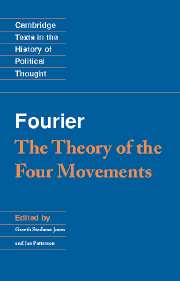Book contents
- Frontmatter
- Contents
- Introduction
- Principal events in Fourier's life
- A brief note on further reading (in English)
- Translator's introduction
- The Theory of the Four Movements and of the General Destinies
- 1808 Introduction
- Preliminary discourse
- Plan
- First part: Exposition of some branches of the general destinies
- Second part: Description of the various branches of the private or domestic destinies
- Third part: Confirmation derived from the inadequacy of the inexact sciences to deal with all the problems that the civilised mechanism presents
- Omitted chapter
- Note A
- Advice to the civilised
- 1818 Introduction
- Index
- Cambridge Texts in the History of Political Thought
1818 Introduction
Published online by Cambridge University Press: 05 June 2012
- Frontmatter
- Contents
- Introduction
- Principal events in Fourier's life
- A brief note on further reading (in English)
- Translator's introduction
- The Theory of the Four Movements and of the General Destinies
- 1808 Introduction
- Preliminary discourse
- Plan
- First part: Exposition of some branches of the general destinies
- Second part: Description of the various branches of the private or domestic destinies
- Third part: Confirmation derived from the inadequacy of the inexact sciences to deal with all the problems that the civilised mechanism presents
- Omitted chapter
- Note A
- Advice to the civilised
- 1818 Introduction
- Index
- Cambridge Texts in the History of Political Thought
Summary
Fourier wrote the following piece, the New Introduction to the Theory of the Four Movements, in 1818, ten years after the work's first publication, and four years before the publication of the Treatise on Domestic and Agricultural Association, which the author was preparing at the time. It was printed in Fourier's lifetime in La Phalange, vol. 1, number 22, in 1837.
Reading this work, you must try to avoid the mistake all the French make: they want a prospectus to contain all the details which properly belong in a treatise, and complain that they cannot understand how the changes I announce will be put into practice. If I had wanted to explain this I would have published a treatise, not a prospectus. It is not appropriate to begin by publishing my Theory; and as I have only published the announcement of it, I do not need to provide anything except a few glimpses to excite curiosity and create a demand for the treatise in which the practical means will be communicated.
My purpose in publishing this book was twofold: to test public opinion and to prevent plagiarism. It was a way of staking my claim, a measure particularly necessary in France where twenty plagiarists lay claim to every discovery and accuse the author himself of plagiarism.
I cast this essay in a form that was sometimes shocking, and varied its tone, in order to disguise the different tests I was making of readers' preconceived ideas, which are stronger in France than anywhere else.
- Type
- Chapter
- Information
- Fourier: 'The Theory of the Four Movements' , pp. 310 - 322Publisher: Cambridge University PressPrint publication year: 1996

